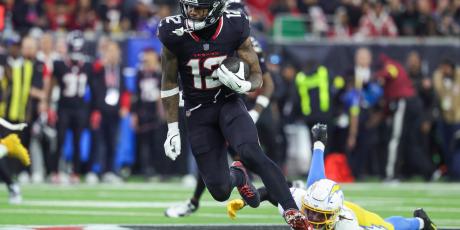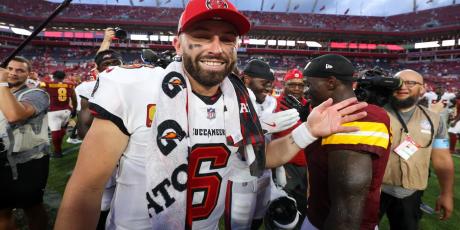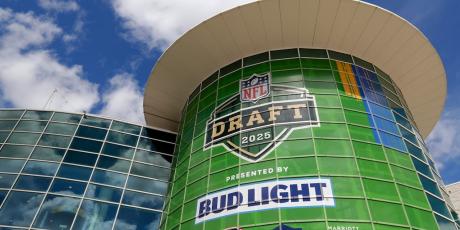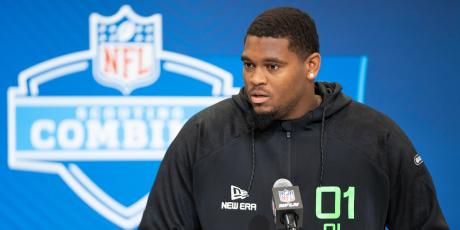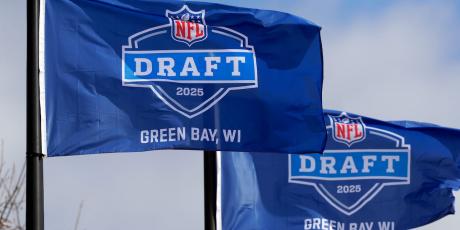Best Ball: Leveraging the Schedule

When a couple of points can make a major difference in the outcome, grinding the extreme edges can provide meaningful benefits. At first glance, the NFL schedule looks like another pointless NFL media event. Contrary to that notion, best ball bros mark this moment weeks earlier with anticipation.
Best Ball Resources: Extreme Underdog Best Ball Roster Construction: When to Stop Drafting WRs | An Intro to Best Ball Leagues | Anatomy of a 'Better in Best Ball' WR | How Draft Date Impacts Best Ball Leagues | How to Approach Underdog 3-Team Best Ball Drafts | Weeks 15-17 Targets for Best Ball Tournaments | The Ultimate Underdog Best Ball Mania V Draft Guide
They are not planning on mapping out wins and losses or marking specific outcomes, but using this new data to optimize teams. Bye weeks impact your ability to advance out of the first round and game stacks influence your odds of surviving and thriving later on.
Bye Weeks
One of my contributions to the discourse in the best ball space has been some graphs I posted about bye weeks last year. Why revisit a generally accepted concept? Understanding the impact further should benefit players instead of merely understanding the directional impact. Regardless of that faction's thoughts, others do not sweat over the differences as much. Sharing bye weeks can result in players being seen on rosters at lower frequencies.
For a while, I’ve had inklings that the data presented in that post overstated the power and effect of byes. The previous approach failed to take into account mitigating factors and considerations. Seeing tight ends share the same bye in a three-tight end build is objectively suboptimal from a points expectation perspective, but was this overstated, and if so by how much? If a drafter neglects to take byes, clearly presented during the draft, into account, are they more likely to disregard positional allocation? I would contend this is almost certainly the case.
Deficiencies in teams are often comorbid. In other words, if a drafter makes sub-optimal decisions in one area of the draft, they are more likely to overlook other commonly accepted advice. Poorly drafted teams frequently have more than one aspect they should improve upon.
A fantastic example of this on the other end of the spectrum is one of Michael Leone’s recent findings. Michael looked into how stacking impacted teams’ expected values and expected win rates in last year’s BBM. During this, he found that teams with more Week 17 game stacks reach the finals more than teams with fewer Week 17 game stacks. Logically this should not be the case, prioritizing potential Week 17 winning odds may result in taking a worse player in a vacuum than if they were not considering this. There are multiple potential takeaways from this finding. In the case here, teams looking for edges on the periphery of others' minds are likely incorporating other pillars of strong best ball teams.
All of this is to say that the data previously presented overstates the impact of bye weeks. The magnitude of the effect was due more to correlated factors than pure causation.
Updated Approach
Instead of purely using the data we observed last year, we can shift player performances to see what results could have looked like with different bye-week structures. If Team 1 had a bye in Week 8, what is ostensibly different if we shift the player’s Week 12 performance to Week 8? The order of performance is inconsequential for regular season purposes. If a player puts up 40 points in Week 1, 7, or 14, this serves the same purpose.
Minor considerations may include injuries accumulating later in the season or pairing player profiles for early and late production. Though this may not always be the case, it should be less of a factor at tight end and quarterback, as production is believed to be more consistent across time.
First, the notation must be aligned to aggregate and interpret findings. Bye weeks are noted based on the order drafted. The first player at the position of interest will always have bye Week A. If the second player at the position of interest shares this bye, they will also have bye Week A but will have bye Week B if they are not the same. The same logic holds for the third player drafted.
To further codify this, players having bye Week 12, bye Week 11, and bye Week 12 would have a bye structure of ABA. Players having bye Week 4, bye Week 12, and bye Week 11 would have a bye structure of ABC. Grouping potential byes into these groups allows more randomization and better aggregation.
Teams are not purely grouped on the count of unique byes but rather on the bye structure because the impact could differ between structures. A team may take a quarterback in Rounds 11, 12, and 18. If earlier quarterbacks have overlapping byes, this should result in a lower expected point total because the cover the last-round player offers is lower than the Round-12 quarterback if the other two were the ones that shared the bye. The impact here likely depends on draft capital investment at each selection.
Each team will randomly be given a group of bye weeks that fit each potential structure. The score for the team is calculated after the theoretical bye week structure is implemented to shift player-level scores. So every team will have a score and advancement marker with each bye structure.
Unfortunately, wide receiver and running back have more considerations as those are more commonly from the same team for stacking purposes. Isolating the impact of bye weeks for those positions is a more involved and difficult process. For those, we will use the same approach I previously used. This involved grouping teams by count of players at the position and count of unique bye weeks. There are notable limitations here, but the approach should help partially answer how bye weeks impact advance rate. Stacking and game stacks should often override the desire for unique bye weeks at these positions.
Tight End
When looking at two tight end teams, teams with one unique bye week scored ~2.7 points less than when they did not overlap on average. This decreased the advance rate by about half of a percent overall. When considering this as a percentage of a percentage, this means overlapping byes decrease your baseline advance rate by 3%.
Why is the impact so small? Well, tight ends score very few points. The replacement values used for better in best ball points and points over replacement are frequently a far cry from the true replacement value on a team. The replacement value used for better in best ball points likely falls close to eight points. When looking at the replacement value within a team, the replacement value is likely to be around three points.

When looking at three tight end builds, the impact of byes is similarly small. Having all of your byes at once resulted in a loss of ~4.2 points compared to teams with no overlapping bye weeks.

The following graph shows the difference in point total between the given structure and the baseline ABC structure. The most frequent difference is zero points. A decent percent of the time the change is surprisingly positive. This is because the randomization and shifting of weeks can lead to more complimentary combinations by chance. Overall ABC scores more points than any other structure on average.

Bye week considerations at tight end likely do not justify seldom selecting players with the same bye week together. Would I continue to use it as a tie-breaker, probably, but I’m open to people not carrying at all. Seeing the initial advance rate decrease by ~3.0% and ~4.6% when shifting from the base scenario of no overlapping bye weeks to condensed bye weeks, I’m open to combinatorial factors and preference playing a larger role than the bye.
While I am opening my stance to considering combinatorial factors, I remain skeptical of the importance of combinatorial considerations. Looking at last season, Jake Ferguson shared a bye week with Dalton Schultz. They were selected together 2237 times. Greg Dulcich, who did not share a bye with Ferguson and had a similar ADP to Schultz, was taken with Ferguson 2633 times. In other instances, the differences can be larger but overlapping byes are taken frequently enough that the discount in occurrences does not overwhelm.
I want to remind people that a small decrease in the first round does have an outside impact compared to benefits in later rounds. Using some very rough estimations, a decrease of ~4% may be close to a ~10% decrease in finals win rate. Player evaluation and preference should likely take the top seat over bye weeks.
Quarterback
Unlike tight ends, quarterbacks make up a much larger percentage of teams’ weekly scores. Accordingly, fielding two quarterbacks with the same bye week resulted in a ~9% decrease in advance rate. Teams only scored ~8.1 points less on average though. This is because the points column is an average and plenty of teams had an injured second quarterback so there was no difference between bye structures. When quarterbacks matter they can really matter.

The three-quarterback table shows the exact pattern we should expect. AAA should have a much lower advance rate and points scored than ABC. All the bye structures in between also show ascending advance rates as expected. Theorizing the effect of semi-shared structures can be difficult, as each likely has marginal differences. Sharing with your top-drafted quarterback is the least optimal. The spread between these semi-shared structures and ABC may be smaller than anticipated but it seems reasonable.

A points change graph pattern mimics that of tight ends, but the shifts become more extreme.

This method has revealed a smaller impact on advance rate than previously believed. I harken back to the points that separate advancing teams from the ones behind them. Despite playing for 14 weeks, small margins often divide winning and losing. Will it make a difference in an individual case? I would bet against it, but over a large sample, it will impact results. Fielding one quarterback with a different bye week adequately insulates you from negative impacts. Ideally, none of your quarterbacks share a bye. Stacking and player preference should hold much greater weight than diversifying your bye weeks, assuming you have two unique byes already.
Running Back
For running back and wide receiver, observed data is being used. The combination of the count of running backs and the count of unique byes had to exceed 1000 teams to qualify.
The differences within the count of running backs make sense as no overlapping byes tend to be the highest advance rate trending down as byes condense. These differences are minor and frequently not meaningful between individual steps. As byes condense further, minor losses accumulate.

Marginal differences should not be the most important factor on your mind when picking. If your early selections at running back share a bye, ensuring you secure options to fill in can make a meaningful difference.
Wide Receiver
Even more so than other positions, sharing bye weeks at receiver is very common. Wide receivers are the most frequently drafted position making completely diversified structures difficult to come by. Additionally, team stacks necessitate taking players with the same bye. This should counteract the negative force of sharing byes.
These counter forces can be observed when looking at last year’s advance rate by positional count and count of unique byes. Teams that shared bye weeks performed marginally better at times. These differences are not large enough to be very confident in them, but logically they hold water.

As discussed in the introduction to bye weeks, poorly constructed teams often can improve in multiple aspects, and well-made teams in one aspect are more likely to be strong in others. Isolating the impact of overlapping byes is a difficult question as teams benefit from potential stacks and may be better built overall when stacked. Condensing onto a couple of byes is far from ideal, especially if all your early picks at the position overlap byes, but stacking and player evaluation should take precedence over byes again. Consider byes but do not shackle yourself to them.
Game Stacks
Stacks have long been a key part of fantasy football. What started as a concept for daily fantasy football, has bled over into other avenues. The most impactful form of stacking will always be team stacking, particularly quarterback to pass catcher. A singular event stands to benefit team stacks multiple times. Increasing the variance helps as prizes for top finishes are outsized compared to finishing high but not at the absolute peak.
A slightly newer but common way to aim for first in daily fantasy involves playing players against other ones in your lineup. If one player or team scores quickly, the other is pushed into a more aggressive script. Additionally, large plays can speed up the game. The majority of the time this will not come to fruition. There are no skeleton keys to winning every time, but we can influence our odds with well-reasoned picks. The goal when constructing lineups should be to tilt the odds in your favor as much as possible. Large field tournaments are more akin to weighted lotteries. You can influence the game to an extent, but results ultimately involve a significant amount of chance.
Applying these daily fantasy concepts to best ball leads people to stack playoff weeks, especially Week 17. While it may seem premature to prescribe which games will go off, this does provide a clearer vision of how specific teams win. The goal is not to determine which game is best, but once you start selecting players, lean into your best path to victory. Let the game come to you. Players you pick early should be a key part of your chances to takedown tournaments, so take that into account and stack them up.
Week 17
Game stacking Week 17 has been a lightning rod topic over the last few years. The logical carryover from daily fantasy indicates that game stacks should matter. Justin Freeman had an interesting thread on game stacks. At times they can be overdone, but when looking at tail outcomes, game stacks can help drafters. The data will not translate one to one as the game at hand is meaningfully different from daily fantasy. Game stacking too much is less of a concern in some ways, but possibly more of one in others. The optionality built into best ball means you are not tied to using the game stack at hand, so if you sacrifice value, this optionality can help mitigate any loss there. Simultaneously, with so much optionality, winning lineups may have to be closer to optimal than winners of daily fantasy tournaments.
When looking at the impact of game stacks, this analysis will focus on how frequently teams pass certain thresholds. The teams used will be those that advanced from the first round. Weeks 15, 16, and 17 will be used and data will be averaged across each Best Ball Mania. So each tournament’s summarized stats hold equal weight. The threshold for Week 17 will be set at being in the top 2.5% of teams weekly.
Using Best Ball Mania IV’s structure, I arrived at 2.5% by focusing on six-figure wins. 20 out of 539 teams get $100,000 or more. (539-1)/20 = ~27. To have a >= 50% chance of being the top one out of 27 is .5 = (1-X)^27. In this case X = ~.025 or 2.5%.

Comparing values to the expected success rate of 0.025, quarterback stacks appear to increase your odds of succeeding in the finals. Adding on to these quarterback stacks, making game stacks, once again looks to increase chances at success.

Are additional game stacks without quarterbacks able to increase chances at success further? Possibly but any benefits look to be very marginal. Marginal changes can make a meaningful difference when aiming for a top 2.5% outcome though. Quarterback game stacks have a more meaningful and repeatable effect on success in the final, these should be priorities when drafting.
Three quarterback game stacks do not appear above because each combination was observed at such a low frequency that it did not qualify for the pivot.

When pivoting quarterback stacks with game stacks, game stacks look to potentially have a minor impact. These game stacks include quarterback game stacks which can be seen to improve the odds of semi-final success above. Taking this into account, I’m inclined to think secondary game stacks barely move the needle, if they do at all. Barely moving the needle can be very meaningful at this stage of the tournament though. Minor game stacks without quarterbacks should not be avoided because they do not hurt, but they should not be a major priority.
While some overstate the impact of these game stacks, the evidence is prevalent that stacking Week 17 does indeed help your win probability. Accordingly, players are acting on this. Looking at BBM IV drafts before and after the NFL draft, there are meaningful changes in game stack frequency. Additionally, higher-volume players tend to value this more than lower-volume players.


The above table shows how many entries users had in BBM IV and the frequency of each count of quarterback game stacks. The quarterback must be stacked and have a bring-back on the other side. High-volume drafters are much more likely to take quarterback game stacks. This is also true about typical quarterback stacks, but the difference is not as large.

If high-volume players, who are more likely to think critically about the game, change their behavior as soon as this schedule information is available, we should give more credence to any findings supporting these. Simultaneously, there could be bias when looking at Week 17 as strong drafters appear to prioritize game stacks so this could boost the observed impact slightly.
Ensure you prioritize quarterback stacks and quarterback stacks. Minor game stacks without quarterbacks should be much less of a priority if they are a priority at all. This sample is still extremely small, so I’m inclined to continue taking minor game stacks, but likely not as much as before. In all likelihood, I will less frequently play into common prioritized combinations without planning on taking one of the associated quarterbacks. Outside of extreme scenarios, I will act on the potential edge of minor stacks.
Week 15/16
Week 15 and 16 are similar to Week 17 but you have to get first and the group is smaller.
Using the same logic but focusing on advancing, the percentile of interest comes out to ~4.5%. This in particular focuses on the week 16 structure in BBM. Week 15 is slightly earlier to get through and would shift the percentile of interest by ~1% to 5.5%.

The figures here are very similar to the changes observed in the Week 17 section. This should be the case as we are using the same data and expanding it to include 2% more successes. Quarterback stacks continue to make the largest difference but adding game stacks looks to make minor performance improvements.

The quarterback game stacks by game stacks pivot supplies more uncertain support of minor stacks. At times randomness has the observed impact up or down from the quarterback game stacks baseline. Samples in these pivots can be rather small, hence why I left out many other combinations. Overall, this pivot gives me more confidence in minor stacks impact on tail-end performance.

I am less certain how much game stacks impact than before. Quarterback stacks continue to be of the utmost importance but game stacks improvements look marginal at best. Changes of .001 in the semi-finals and finals equate to changes of 2% and 4%, respectively. Improvements by those margins should not be scoffed at.
Depending on how you break down this data, the improvements can be seen or created depending on your original perspective. Theoretically, the logic behind them holds enough water that I am going to lean into those priors because we’re operating based on a three-game sample for four tournaments.
Other methods of drilling into this data have supplied more supporting findings, which also helps preserve my faith. With how frequently I reference his work, you may think Michael Leone is my idol, and you’d be correct. Despite having a studio, I have a shrine to him. We all have priorities. I digress – Leone recently commented on how Week 15 and 16 stacks are underutilized. Additionally, Sackreligious from Legendary Upside wrote about the impact of different interactions on your theoretical win odds in those rounds. These edges are observably underutilized. Remembering every matchup may be impractical for mobile drafts on the go, but when possible it should be accounted for.
Wrap Up
Thank you for bearing with me while I tested your interest in bye-week discussions and threw in some game stacking information. While this may be helping me discover my true fans, I’m afraid the “True Fan” theory wasn’t imploring you to immediately test your potential fans’ interest to the edges of their tolerance. If you want more bye week discussions or numbers from other BBMs, you can harass me on Twitter @FeilNarley.
For more best ball, season-long, betting or other sports content subscribe to 4fo4.


